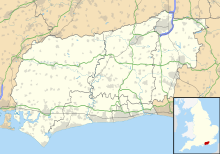RAF Tangmere
|
RAF Tangmere |
|||||||||||||||
|---|---|---|---|---|---|---|---|---|---|---|---|---|---|---|---|

Station crest
|
|||||||||||||||
| Summary | |||||||||||||||
| Airport type | Military | ||||||||||||||
| Operator | Royal Air Force | ||||||||||||||
| Location | Tangmere | ||||||||||||||
| Coordinates | 50°50′45″N 000°42′23″W / 50.84583°N 0.70639°WCoordinates: 50°50′45″N 000°42′23″W / 50.84583°N 0.70639°W | ||||||||||||||
| Map | |||||||||||||||
| Location in West Sussex | |||||||||||||||
| Runways | |||||||||||||||
|
|||||||||||||||
RAF Tangmere which was in Tangmere, 3 miles (5 km) east of Chichester, West Sussex, England, was a Royal Air Force station famous for its role in the Battle of Britain. Famous Second World War aces wing commander Douglas Bader, and the then inexperienced Johnnie Johnson were at Tangmere in 1941.
The aerodrome was founded in 1917 for use by the Royal Flying Corps as a training base. In 1918 it was turned over to the American Air Force as a training ground, and continued as such until the end of the Great War in November of that year, after which the airfield was mothballed.
In 1925 the station re-opened to serve the RAF's Fleet Air Arm, and went operational in 1926 with No. 43 Squadron equipped with biplane Gloster Gamecocks (there is still a row of houses near the museum entrance called Gamecock Terrace).
As war threatened in the late thirties, the fighters became faster, with Hawker Furies, Gloster Gladiators, and the Hawker Hurricanes powered by the famous Merlin engines all being used at Tangmere. In 1939 the airfield was enlarged to defend the south coast against attack by the Luftwaffe, with Tangmere's only hotel and some houses being demolished in the process. The RAF commandeered the majority of houses in the centre of the village, with only six to eight families being allowed to stay. It was only in 1966 that the village resumed its status as a civilian community.
In August 1940 the first squadron (No. 602 Squadron RAF) of Supermarine Spitfires was based at the satellite airfield at nearby Westhampnett, as the Battle of Britain began. By now the villagers had mainly been evacuated, and extensive ranges of RAF buildings had sprung up.
...
Wikipedia

